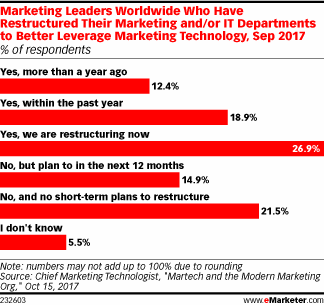If there’s one thing thing that marketers should remember from Wayfair and LiveIntent’s panel during this year’s Advertising Week, is that they need to see themselves as part storyteller and part technologist.
Why technologist? Because marketing software and automation has taken off, and it’s not enough to simply manage these platforms. Marketers can now work together with IT or engineering internally, and partners externally, to develop and implement the right tools to better reach and communicate with the customer. They need to truly understand the context of how these technologies work and how they can be applied across the marketing team to achieve business goals. As a matter of fact, marketing leaders globally are restructuring teams and now creating specific roles that can deal with marketing technology.

Wayfair, from the very beginning, has always had a “build it” versus “buy it” mentality. After all, they often describe the business as a technology company that happens to sell furniture (in jest, of course). They’ve built their own technology which allows the marketing team to have a single view of the customer. This enables them to think about how they’re communicating to their customers in the most compelling or consistent way, ensuring that they “show up” wherever the customer is and provide the best experience.
Jess Jacobs, Director of Marketing at Wayfair, highlighted just how important that customer experience is.
“Our customer is coming in and out,” said Jess. “It’s [the customer journey] never as linear as you hope it to be…we want to reach our customer wherever she is…”
Even though they take a broad approach to marketing and media – from television to direct mail – marketing technology is integral to managing customer information, understanding how effective website and marketing efforts are, and identifying or having a single view of the customer and their behavior across all touchpoints off-site and on-site.
The challenge with using many disparate systems and platforms is that it can be very hard to have a singular view of the customer, and activate it in real time across different channels. As Nick Dujnic, VP of Marketing at LiveIntent described, “It’s like a constellation, where you have a view of a customer, but it’s actually all these dots and you don’t actually see the full picture until you draw the lines.”
This is where Wayfair’s technologist culture kicks in and their POV around building over buying:
“…because we’re not constantly chasing how we’re going to replace a key part of our tech stack…we can actually take the time to be thoughtful about our strategy and build the tools that allow us to then do these things, which is a more thoughtful way to communicate with the customer – it frees up the time,” said Jess.
Jess described the email address as the “common currency” to tie customers to each other and their behavior across many platforms. It’s one of the key data points they find most predictive and most important in reaching known customers or building acquisition.
And when they’re not using internal technology, they lean in to platforms that give them the ability to activate against audiences on their terms, where they can bring their own audience segments and data, and be quite finely honed in the messaging, willingness to pay and frequency. Value is seen in platforms that exercise transparency from performance of campaign, to granular impression level data. This is important because Wayfair has their own in-house attribution model. If they are able to get a deep level of granular data, they can flow that information directly into their attribution model which allows them to be more targeted, and also be more savvy when it comes to thinking about the right marketing investments for their business.
Transparency also extends to having a close strategic partnership – understanding a given partner’s product roadmap, sharing how Wayfair is trying to evolve their business, and partnering to jointly develop solutions to get them there.
This innovative and technologist culture proves just how Wayfair has been able to conquer adtech and martech convergence. Some marketers aren’t ready, but having the technologist mindset is one step in the right direction.
See more of the discussion around Wayfair’s acquisition strategy, understanding the customer, and omnichannel approach on video here.
What You Should Know:
Digiday Advertising Week Briefing
Webinar On Demand: Pioneer The Final Frontier of Marketing
Forrester Study: The Next Era of Marketing Is Coming. It’s People-Based
The post Marketers Need To Think Like Technologists appeared first on LiveIntent Blog.
